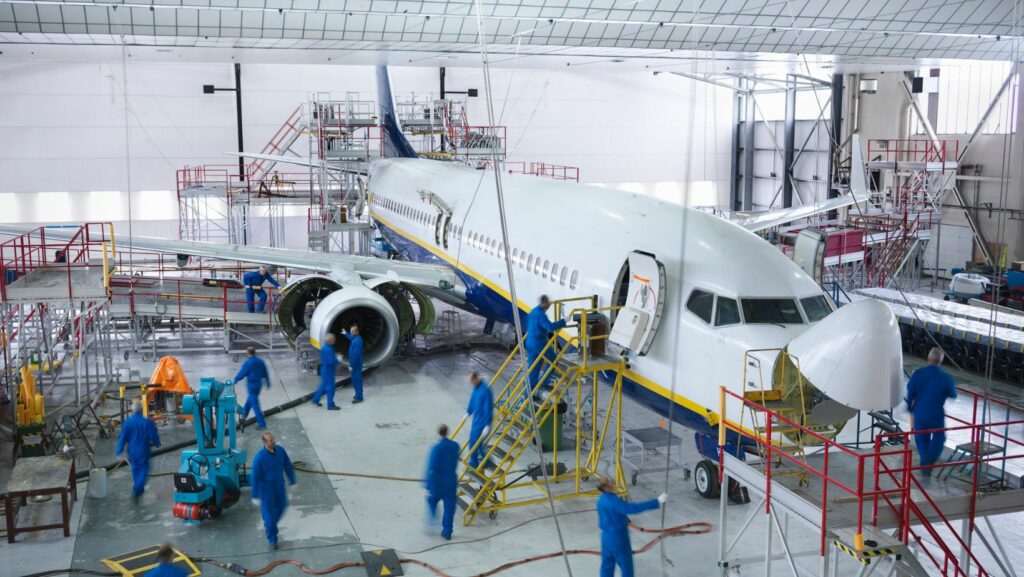In the vast expanse of the cosmos, humanity’s quest for exploration has given birth to the groundbreaking field of aerospace. This fascinating realm, where science, technology, and innovation intersect, is the focus of our exploration today. We’ll delve into some awe-inspiring examples of aerospace, shedding light on the marvels that make space exploration possible.
From the iconic space shuttles that grace our skies to the intricate satellites orbiting our planet, aerospace examples are all around us. They’re not just about reaching for the stars, but also about enhancing our understanding of the universe and improving life on Earth. So, buckle up as we embark on this exciting journey through the world of aerospace.
Aerospace Examples
Commercial Aerospace Examples
 In the realm of commercial aeronautics, the Boeing 747 represents one of the finest. Boeing’s larger-than-life brainchild, it quickly became an international symbol of air travel. Another significant example is SpaceX’s Falcon 9. Notorious for its ability to reenter Earth’s atmosphere and land vertically, it’s a firm testament to technological advancement in aerospace. Commercial satellites, such as the Sirius XM satellite, also belong to the list of noteworthy commercial examples. Providing radio service to consumers, it boosts the industry’s impact on terrestrial communication.
In the realm of commercial aeronautics, the Boeing 747 represents one of the finest. Boeing’s larger-than-life brainchild, it quickly became an international symbol of air travel. Another significant example is SpaceX’s Falcon 9. Notorious for its ability to reenter Earth’s atmosphere and land vertically, it’s a firm testament to technological advancement in aerospace. Commercial satellites, such as the Sirius XM satellite, also belong to the list of noteworthy commercial examples. Providing radio service to consumers, it boosts the industry’s impact on terrestrial communication.
Military Aerospace Examples
When it comes to military aerospace, the F-35 Lightning II fighter jet stands out. Manufactured by Lockheed Martin, it serves as a testament to the potency of military aviation. The Global Hawk Unmanned Aircraft System is another notable example, offering unmanned aerial reconnaissance capabilities. Additionally, military satellites, like the Global Positioning System (GPS) satellite from the Department of Defense, underscore the vital role aerospace plays in national security. These satellites provide precise positioning data, significantly enhancing military operations.
Aerospace Examples: Companies Setting the Pace
Blue-Chip Aerospace Firms
These powerhouses in aerospace uphold high standards, making them instrumental in propelling the sector forward. Three prime examples include Boeing, Lockheed Martin, and Airbus. Boeing, a major manufacturer of commercial jetliners and defense systems, notches constant innovation. Lockheed Martin, meanwhile, leads in security and aerospace, notably in areas such as aeronautics and missiles. Airbus, popular for its commercial aircraft, also excels in helicopter production and space-related services.
Emerging Aerospace Enterprises Worth Watching
 In contrast to the established entities, numerous start-ups are shaking the aerospace sector with groundbreaking ideas. SpaceX, Colony, and Relativity Space sit among this band of innovators. SpaceX, under Elon Musk’s guidance, disrupts conventional space travel narratives, symbolized by the impressively reusable Falcon 9 rocket. Colony, meanwhile, proposes asteroid mining, an ambitious endeavor that could revolutionize resource gathering. Lastly, Relativity Space brings a unique approach with their fully 3D-printed rocket, pushing the boundaries of manufacturing norms.
In contrast to the established entities, numerous start-ups are shaking the aerospace sector with groundbreaking ideas. SpaceX, Colony, and Relativity Space sit among this band of innovators. SpaceX, under Elon Musk’s guidance, disrupts conventional space travel narratives, symbolized by the impressively reusable Falcon 9 rocket. Colony, meanwhile, proposes asteroid mining, an ambitious endeavor that could revolutionize resource gathering. Lastly, Relativity Space brings a unique approach with their fully 3D-printed rocket, pushing the boundaries of manufacturing norms.
Future Predictions for the Aerospace Sector
Anticipated Trends in Aerospace Technology
Emerging trends anticipate a turning tide in aerospace technology. Concepts like autonomous flight systems are becoming reality, with numerous projects underway to develop AI-driven cargoes and passenger planes. Likewise, hypersonics, enabling speeds over Mach 5, promise to revolutionize long-haul travel by significantly shortening flight duration. Additionally, 3D printing stands at the frontier of aerospace manufacturing.
The Role of Sustainability in Future Aerospace Developments
 Sustainability lies at the core of future aerospace advancements. With growing environmental concern, the industry is steering towards eco-efficient technologies. Among them, green propulsion systems featuring hybrid electric engines, biofuels, and hydrogen cells offer promise to significantly cut down on CO2 emissions. This environmental focus also extends to space debris management. In the future, it’s anticipated that initiatives promoting clean space protocols will gain momentum to prevent the cluttering of orbital paths around Earth.
Sustainability lies at the core of future aerospace advancements. With growing environmental concern, the industry is steering towards eco-efficient technologies. Among them, green propulsion systems featuring hybrid electric engines, biofuels, and hydrogen cells offer promise to significantly cut down on CO2 emissions. This environmental focus also extends to space debris management. In the future, it’s anticipated that initiatives promoting clean space protocols will gain momentum to prevent the cluttering of orbital paths around Earth.
Technological Force
The aerospace industry’s importance can’t be overstated. It’s the driving force behind groundbreaking innovations and technological advancements that are transforming our world. From the production of aircraft and space systems to the development of defense strategies, it’s a sector that’s deeply woven into the fabric of modern society. The aerospace industry has given us iconic examples like the Boeing 747 and SpaceX’s Falcon 9, symbolizing progress and innovation. It’s also been instrumental in defense, with creations such as the F-35 Lightning II fighter jet and the Global Hawk Unmanned Aircraft System.



